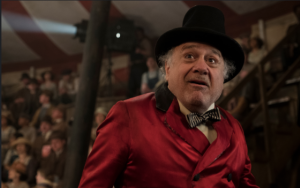RICHARD’S CTV NEWSCHANNEL REVIEWS FOR MAY 27 WITH MARCIA MACMILLAN.
 Richard joins CTV NewsChannel anchor Marcia MacMillan to talk about the highway to the danger zone and Tom Cruise in “Top Gun: Maverick.”
Richard joins CTV NewsChannel anchor Marcia MacMillan to talk about the highway to the danger zone and Tom Cruise in “Top Gun: Maverick.”
Watch the whole thing HERE!
 Richard joins CTV NewsChannel anchor Marcia MacMillan to talk about the highway to the danger zone and Tom Cruise in “Top Gun: Maverick.”
Richard joins CTV NewsChannel anchor Marcia MacMillan to talk about the highway to the danger zone and Tom Cruise in “Top Gun: Maverick.”
Watch the whole thing HERE!
It’s been thirty-six years, but movie goers can once again ride into the danger zone.
Kind of.
Hotheaded test pilot Pete “Maverick” Mitchell (Tom Cruise) returns to the screen and sky in the high-flying sequel “Top Gun: Maverick,” which, despite the main character’s feats of daring do, plays it mostly by-the-book.
When we first get reacquainted with Captain Maverick, he’s still the hotshot, risky pilot we remember from the first film. His cocky attitude and bad boy behavior has kept him from being promoted. “I’m where I belong,” he says when asked why he’s not an Admiral after decades of distinguished service. He’s popular with his peers but not with the brass, save for his old friend and guardian angel, Admiral Tom “Iceman” Kazansky (Val Kilmer in an extended cameo).
“Your reputation precedes you,” says Vice Admiral Beau “Cyclone” Simpson (Jon Hamm). “That’s not a compliment.”
Called back to Top Gun, the United States Navy training program where he learned fighter and strike tactics and technique, Maverick is presented with a last chance for glory. “You fly for Top Gun or you don’t ever fly for the Navy again.”
Cyclone is obviously disdainful of the arrogant Maverick, but acknowledges he is the best person to train twelve of the brightest and best recent Top Gun graduates for a dangerous mission to locate and destroy an underground uranium enrichment site.
For Maverick, the job comes with baggage. It places him in the vicinity of on-again, off-again girlfriend Penny (Jennifer Connelly), a new character, referenced in the first film as the daughter of an admiral. Most dramatically, one of his students is Lieutenant Bradley “Rooster” Bradshaw (Miles Teller), the son of Maverick’s late best friend, “Goose,” played by Anthony Edwards in the first film. Rooster holds Maverick responsible for his father’s death and is resistant to Maverick’s training. “My dad believed in you,” he says. “I’m not going to make the same mistake.”
Of the twelve recruits, half will make the cut, one will be the leader, if Maverick can teach them the precision and “Don’t think, just do” attitude needed to come home alive.
“Top Gun: Maverick” screenwriters Ehren Kruger, Eric Warren Singer and Christopher McQuarrie keep the story simple; a splash of romance, a dash of remorse, some shirtless volleyball and a mountain of eye-popping aerial action. It’s a recipe that echoes the events of the first film to the point of déjà vu. Still, as an exercise in nostalgia, complete with callbacks to the original, and an emotional appearance by Kilmer, “Maverick” works because it blends old and new in a crowd-pleasing way. Unlike other recent 1980s and 1990s reboots, it salutes the original in tribute. Loud and proud, it wears its superficiality on its sleeve in an old fashioned, last century style that is unabashed fan service.
But what really sets the new and old films apart is Cruise. He was a movie star then, and he’s a movie star now, but with age, the stakes for his character are higher. Maverick has a lot to prove, regrets to be dealt with and while the actor doesn’t appear to have aged at all, that trademarked Tom Cruise Run can’t be as easy as it once was. Maverick is a still a hotshot, but here the character is tempered by the sins of the past and a real concern for the future. Cruise’s work shaves some of the hypermasculine edges off Maverick to reveal a more human and humane character than the first time around. It centers the movie with some earthbound emotion to counter the sky-high action.
“Top Gun: Maverick” is a sequel that plays it safe with the story, but lets it rip in the blockbuster action sequences, giving the audience the expected need for speed.
 On this week’s edition of “Pop Life” comedy legend Danny DeVito reflects on the different characters he’s played, working with Tim Burton on “Dumbo” and his audition for the TV show “Taxi.” Then, the “Pop Life” panel, comedian Micheal McCreary, tech expert Takara Small and author and broadcaster Dan Riskin, discuss the term ‘outsider’ and the benefits of being unique.
On this week’s edition of “Pop Life” comedy legend Danny DeVito reflects on the different characters he’s played, working with Tim Burton on “Dumbo” and his audition for the TV show “Taxi.” Then, the “Pop Life” panel, comedian Micheal McCreary, tech expert Takara Small and author and broadcaster Dan Riskin, discuss the term ‘outsider’ and the benefits of being unique.
Watch the whole thing HERE!
Film critic and pop culture historian Richard Crouse shares a toast with celebrity guests and entertainment pundits every week on CTV News Channel’s talk show POP LIFE.
Featuring in-depth discussion and debate on pop culture and modern life, POP LIFE features sit-down interviews with celebrities from across the entertainment world, including rock legends Sting and Meat Loaf, musicians Josh Groban and Sarah Brightman, comedian Ken Jeong, writer Fran Lebowitz, superstar jazz musician Diana Krall, stand-up comedian and CNN host W. Kamau Bell, actors Danny DeVito and Jay Baruchel, celebrity chefs Bobby Flay and Nigella Lawson, and many more.
 This week on “Pop Life” comedy legend Danny DeVito reflects on the different characters he’s played, working with Tim Burton on “Dumbo” and his audition for the TV show “Taxi.”
This week on “Pop Life” comedy legend Danny DeVito reflects on the different characters he’s played, working with Tim Burton on “Dumbo” and his audition for the TV show “Taxi.”
“I read this thing was that you should go into a room and take it over, psychologically. So, in other words you want change the room in your own way. I can’t remember if it was Stanislavsky or acting coach or teacher, or who it was.
I used to go in and do things just to make an impression. I don’t even know if I had to but I did. With ‘Taxi’ there’s my famous story where I go in and they’re all in there and I’m going to go sit in the hot seat and read it. And it’s the first audition for that I had for the show and I said to them, “There’s one thing I want to know before I start. Who wrote this shit?” and I threw it on the table. It was like Louie walked into their lives. That was bold, but it worked. ‘Taxi’ was like a gift.”
Watch the whole thing HERE!
Film critic and pop culture historian Richard Crouse shares a toast with celebrity guests and entertainment pundits every week on CTV News Channel’s talk show POP LIFE.
Featuring in-depth discussion and debate on pop culture and modern life, POP LIFE features sit-down interviews with celebrities from across the entertainment world, including rock legends Sting and Meat Loaf, musicians Josh Groban and Sarah Brightman, comedian Ken Jeong, writer Fran Lebowitz, superstar jazz musician Diana Krall, stand-up comedian and CNN host W. Kamau Bell, actors Danny DeVito and Jay Baruchel, celebrity chefs Bobby Flay and Nigella Lawson, and many more.
Much of Tim Burton’s live action remake of the Disney classic “Dumbo” concerns itself with putting on a great show. Set in a travelling circus whose ringmaster Max Medici (Danny DeVito) is always looking for new ways to entertain people, the movie made me ask, “Is it possible to put on too much show?”
The Medici Brothers Circus has seen better days. Crowds are sparse and to keep the travelling circus afloat Max has sold off their show horses. When former circus star Holt Farrier (Colin Farrell) returns, injured from the war, his dream of starring in the big top are dashed. The only job available is tending to newly acquired elephant Jumbo. Medici purchased the pregnant pachyderm with the hope of having a baby elephant on display will sell tickets.
When the baby is born Max is convinced that Little Jumbo’s gigantic, floppy ears will turn him into a laughing stock and actually turn audiences off. It’s not until Farrier’s kids, Milly (Nico Parker) and Joe (Finley Hobbins), discover Little Jumbo—now dubbed Dumbo after a catastrophic big top debut—can flap his ears like wings and fly that Max sees a way to earn back his investment. Enter amusement park entrepreneur V. A. Vandevere (Michael Keaton) with an offer that could save the circus or endanger everyone, most of all Dumbo.
“Dumbo” treads familiar ground for director Tim Burton. His best films tell stories of outsiders like Pee-Wee Herman, Edward Scissorhands or Ed Wood, lovable characters who weren’t quite made for this world. He’s drawn to outcasts but finds a narrative route for them to find a connection and a sense of community through their abilities and art. “Dumbo” breathes the same air, focussing on old-fashioned caricatures of circus folk like strongmen and mermaids, and, of course, the underdog elephant whose unique ability makes him a hero.
As such “Dumbo” feels like a Tim Burton movie rather than a remake of the 1941 film. His trademark whimsy is fully on display in the form of highly stylized design, fanciful casting and costuming and, “What’s a Tim Burton movie without Danny DeVito?” It looks and feel like a Burton film for better and for worse.
The better is his unique and heartfelt love of the unloved. He coddles his characters, imbuing Dumbo with soulful eyes to compliment his outsize ears. It’s almost impossible to understand how anyone couldn’t see the beauty in this unusual creature. Dumbo is a waif, an innocent whose inner beauty and strength is well beyond his years. Burton gets the character and keeps Dumbo mostly front and centre as the action swirls around him.
Here’s the issue. There’s too much action. The original film was a brief 63 minutes, a tight telling of the tale. Burton almost doubles that length, adding in anti-corporate subplots, action sequences and new characters. Near the film’s end, however, the extra elements feel superfluous, unnecessary. Sometimes more is less. The heart of the story is found in Dumbo’s character not the layers of CGI action that surround him.
Having said that, “Dumbo” is a treat for the peepers. Every detail from the costumes to Medici’s grinning faced-train are pure Burton eye-candy. Fun performances from DeVito and Keaton keep things lively and the pro-animal message is heartfelt adding up to a movie that doesn’t seem to trust its star, a flying elephant, to be enough of a draw.
Can you steal someone’s life? It’s the question at the heart of “Ghost in the Shell,” in more ways than one.
Based on the Japanese manga of the same name by Masamune Shirow, it centers around a woman, played by Scarlett Johansson, rescued by scientists at AI robots manufacturer Hanka Robotics and turned into a weaponized cyber-human. “Your body was damaged,” says Dr. Ouelet (Juliette Binoche). “We couldn’t save it, only your brain survived.” Named The Major (more on that later) after her cerebral salvage she leads task force Section 9 who take down cyber terrorists and hackers by any means necessary. “We saved you,” continues Dr. Ouelet, “and now you save others.” The life the Major once knew is over but as the doctor says, “Your mind, your soul and your ghost, that’s still in there.”
On another level “The Ghost in the Shell” steals away the essence of itskmain character. The Major, or Major Motoko Kusanagi as she was referred to in the 1989 manga series and beyond, is a Japanese character in this case being played by the very western Johansson. Director Rupert Sanders dismisses the whitewashing criticism saying, “I feel that [Johansson] channelled the Major better than anyone else I could have thought of. She was my first choice and remains my first choice. She’s the best actress of my generation and her generation and the person I felt most embodied the physicality and the ability to inhabit that role.”
I think Sanders forgot to insert the word “bankable” in there somewhere.
I’m not suggesting that Johansson isn’t a talented actor or capable of pulling off believable and exciting action scenes. In movies like “Lucy” and “Captain America: Civil War” she has credibly occupied the action space, bringing both toughness and acting chops to her roles. That’s not at issue. What is at issue here is that the character is decidedly Japanese. As a human brain in an entirely synthetic body, she is far from, as Johansson claims, “identity-less.” In fact she is the very embodiment of a culture’s fascination with technology and how that technology interacts with humankind. In this case the technology actually becomes human, or perhaps it’s the other way round. Either way, the cyberpunk heroine is a key figure in Asian science fiction and the new “Ghost in the Shell” conveniently ignores that fact.
More thought has been put into creating the world The Major interacts with. A mix of the original anime, “Minority Report,” and “Robocop” with a taste of “Blade Runner” and “The Matrix” thrown in for completists, it’s a sleek near future environment, dense with activity, like in New York City and Hong Kong had a baby.
It is also a place where it’s now possible to control people by hacking directly into their minds. To combat this invasion of the mind, the Major and Co. have their sights set on Kuze (Michael Carmen Pitt), a shadowy cyber terrorist who is targeting Hanka scientists. Complicating the mission are nagging memories of The Major’s former life that manifest themselves through a glitch in her wiring. She sees strange visions, sort of sensory echoes that hint at memories just out of reach. They are the ghost in the shell. She’s sort of like a high tech Jason Bourne, deadly with little recall of the past. “Who are you?” asks a woman who may or may not be The Major’s mother. “I don’t know,” Maj says with a faraway look.
To get to the bottom of the artificial intelligence technology conspiracy that landed her with Handa Robotics, The Major goes rogue. “They created me,” she says, “but they cannot control me.”
One of the most popular Japanese animated series of all time, “Ghost in the Shell” is a beautiful looking movie, which, like its main character, is in search of its soul. Director Rupert Sanders has an extraordinary eye, whether he is visualizing the hacking of The Major’s mind, creating a nightmarish nightclub sequence or bringing surreal cityscapes complete with video statues and future world architecture to vivid life. The movie is never less that entertaining for the eye, passing the time in a wild swirl of colour and movement.
It’s a shame the story isn’t as entertaining. Filtered through a Hollywood lens, what was once a seminal work of cyber punk is reduced to a superhero origin story with action scenes aplenty. Most are beautifully staged even though the odd shot feels like out takes from an upcoming Black Widow spin off.
Johansson pulls off the cold efficiency of a machine tempered with emerging human feelings. She’s a killing machine but never more human than when she explores what it feels like to be flesh and blood, not synthetics and wires. Its territory she’s tread before, most notably and more effectively in “Under the Skin” but it’s an otherworldliness that suits the role.
Binoche as the empathetic AI specialist and mother figure is terrific and the legendary ‘Beat’ Takeshi Kitano isn’t given much to do, but does it with aplomb.
“Ghost in the Shell” is a gorgeous looking film that will engage the eye but not the brain.